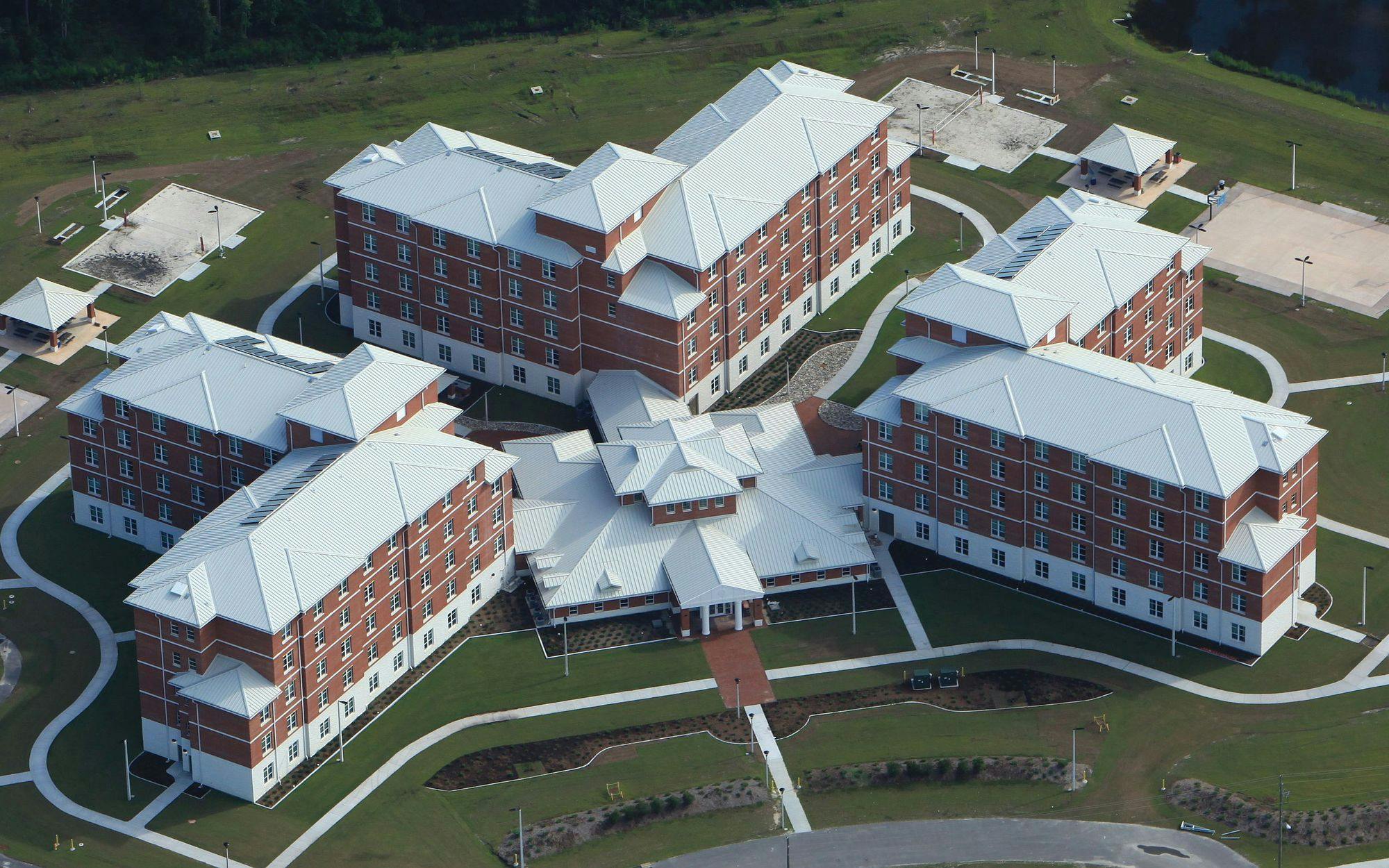
Boots on the Ground: A Primer on Military Construction
In 2017 alone, the Department of Defense—the largest contracting agency in the federal government—shelled out about $320 billion for contracted work to plan, program, design and build runways, piers, warehouses, barracks, schools, hospitals, child development centers and other facilities needed to support U.S. military forces at home and overseas.
Military construction is a vital, significant field, comprising an expanse of contracts. With such a breadth of coverage, not to mention the maintenance required after these structures are built, contractors must cater, quite meticulously, to this niche market.
DOCUMENTATION, ALLOCATION AND ADMINISTRATION
Military construction projects differ from commercial and institutional construction projects in several key ways.
- Requirements involving the documentation process are very stringent.
- Funds allocated are often withheld for lengthy amounts of time.
- Federal codification is involved to a minute degree, deciding how bids are solicited and when construction can start.
Title 40 of the United States Code (§ 1101 et seq.) requires that federal building projects go through a three-step “design-bid-build” process in which an initial design phase is followed by competitive bids from construction firms and the actual construction. And each of these phases is governed by a specific contract.
DoD contractors may use the shorter design-build process, via Section 2305a of Title 10, if it is determined that:
- three or more offers are anticipated for the contract;
- design work must be performed prior development of a proposal by any of the offerors; and
- a substantial amount of expense will be incurred by the offeror while preparing the offer.
And that’s just to get started. Once a contractor is approved, a project scope must be drawn that meets tight government regulations, and contracts are never finalized until the associated funding is authorized—which can take years, depending on the project and Congressional budgetary decisions.
Christopher Gray, project executive for Roy Anderson Corp., says that an additional complication is that, while each branch of the military has standard documentation and submittal procedures, “they do vary from each managing service of the military to the next. You, as a contractor, have to understand those requirements associated with your contract.” The kicker? “There are no shortcuts and the submissions have to be exactly as required.”
This is why, with all of those hoops to jump through, even though military projects comprise just 15%-25% of RAC’s annual revenue, the general contractor created a position to oversee all of the appended paperwork with a keen eye. With 26 years in the business—and 12 of them spent in the military sector—Gray is confident that his mentee, Leonard Ash, project executive of federal works, has the experience to keep the proverbial ball rolling. Together with a federal proposal writer, Ash ensures that RAC’s federal packages not only adhere to standard operating procedure, but also present the “best value,” Gray says.
Bureaucracy can be a positive flipside for the company as a whole. From Gray’s perspective, “It may seem like overkill, but you learn a lot about how to document projects.” Of course, there will be a learning curve and inspections will seem difficult because, as Gray puts it, “you’re not going to skip the guy in the middle,” but it’s that very check-the-box attitude that can set your whole organization up for success if you choose to adopt it elsewhere. “Once you become proficient with [the process], you are sure to have safe projects with the quality end users expect,” Gray confirms.
Another benefit? A record of your work. Unnerving or not, Uncle Sam is keeping tabs, and government work is one of the few market sectors that consistently requires reviews mid-project. Over the course of a single contracted job, a federal client will conduct multiple interim reviews, citing both pros and cons. Once the work has been completed, a contractor will receive these reviews in a performance report.
“That’s valuable to have and share with the next client,” Gray says. “I also think there’s some sharing of your score, rank and review within the federal agencies,” which assists contractors with acquiring more work. It has certainly been a boon for RAC, which has become a go-to for federal contracts, including disaster relief work in Texas and Louisiana.
OCCUPATIONAL HAZARDS
An overset of paperwork isn’t the only trait setting this sector apart. Jason Hard, vice president and division manager at Brasfield & Gorrie, explains that “every military project is unique and presents unique opportunities.” Keeping in mind that the same issues present at commercial and institutional jobsites, such as damaging weather and delayed materials, are additional obstacles, Gray and Hard mention these standouts particular to military projects:
- ensuring subcontracted trade partners understand the nuances of federal requirements;
- agencies might change entire programs in the middle of a project;
- restricted access to skilled trade workers due to the propensity for military projects to build in small or remote population centers; and
- locating subcontractors and workers who value the high quality and safety requirements of military work.
Although military projects also see a high rate of cancelation and delay, neither RAC nor Brasfield & Gorrie have been particularly affected by this state of play. “RAC has a diverse project portfolio,” Gray comments. “Certainly a lack of military projects affects our pursuits, but when the projects we would generally pursue are lacking, delayed or cut, we shift focus to other sectors in order to meet our goals.”
Similarly, Hard confirms that, regardless of a recent cancellation of a project due to cut funding, Brasfield & Gorrie is “not significantly affected by these changes.” He also encourages other contractors to maintain a diversified mix of projects and adds that they should follow the DoD’s budget in order to forecast military construction spending and adjust accordingly. “There is always a level of uncertainty in our nation’s budgeting process,” he says. (See sidebar on p. 29.)
‘SAFE’ IS THE WORD
The military possesses an exacting reputation for safety, and the construction industry must meet its very high standards.
In 2018, the U.S. Government Accountability Office reviewed 192 companies with DoD contracts, and of those sampled, 106 had been inspected by the Department of Labor, OSHA or the state occupational safety and health administration during FY 2013-17. Eighty percent were found to have committed at least one violation, and 83 companies were cited for at least one violation, including 52 with at least one serious violation.
At Roy Anderson Corp., those statistics are taken seriously. Federal projects are just as stringent about safety as they are about documentation—a Site Safety Health Officer who plans work, detects and corrects hazards on the jobsite, and provides necessary safety and health training is required, full-time, at each jobsite—but RAC has paralleled the government’s rigor across the majority of its private projects, too. “Our safety program is the same, whether it is a federal/military project or a private project,” Gray says.
Brasfield & Gorrie, number eight on ABC’s Top PerformersTM list of 2019, takes a similar approach on health and safety. “We also use the EM 385-1-1 Safety and Health Manual, as required by the U.S. Army Corp of Engineers and the Naval Facilities Engineering Command,” Hard says. In addition to staffing an SSHO on every project and employing a consistent strategy brand-wide, the contractor uses a specialized safety, health and environmental management system to provide consistent guidance to each employee on its projects. Tools include daily pre-task planning, regular safety walks by superintendents and/or project managers and routine site-wide safety meetings.
MASTER IN THE FIELD
A repeat winner of ABC’s Excellence in Construction® Awards, Brasfield & Gorrie’s military projects set the company apart from the crowd. Two of its projects won the National Excellence Award and a third snagged the Pyramid Award—all design-build projects, meaning that the contractor had sole responsibility for the entire deliverable, soup to nuts. “Our strategy was to offer the best-value solution to the government’s request for proposals,” Hard says. “We included betterments and solutions that enhanced each project’s mission: improving functional use.”
Hard has a point. Military-style buildings are often stereotyped as stark and utilitarian, lacking in creativity. A modern contractor responsible for these builds not only has to combat those stereotypes, but also must work within a budget and model that tends to conform to those stereotypes. What’s a contractor to do? Focus on “providing them with the highest-quality living environment and experience possible while exceeding the government’s energy efficiency goals,” Hard says, referencing the company’s project at the Camp Lejeune Wallace Creek Bachelors Enlisted Quarters in North Carolina.
In the case of the Fort Bragg Kimberly Hampton School, also based in North Carolina, Brasfield & Gorrie paired with educators and planners during the design phase so that they could tailor that critical “functionality” element to the resource needs of teachers at the facility. Another prime example, the MCAS Cherry Point Marine Air Support Squadron (MASS-1), located in Havelock, North Carolina, involved engaging with the Marine Corps to understand operational capabilities and logistical requirements so that the design of supply and maintenance elements would be able to better support the project owner’s mission.
This collaborative, nuanced technique has allowed each project to result in its users’ success. Brasfield & Gorrie always aims, Hard says, to “maximize value to the end user,” which, given their substantial trophy case, has been a realization for the company thus far.
PRACTICED PERFECTION
Another winner of several EIC Awards, including an Eagle Award in 2018 and a Pyramid Award in 2017, RAC is no stranger to challenge or success. In fact, its work on the VA Medical Center Laundry-Dietetics Building in Biloxi, Mississippi, earned the company a Pyramid Award in the Federal Government $10-100 Million Category in 2016.
Utilizing both electricity and green power, the 81,000-square-foot building operates using smart technology and automation. The space contains a “steamless” laundry facility (one of only a half-dozen in the country at the time of completion), a dietetics facility, an office space and additional storage.
This project is significant due to its status as the first of its kind to be constructed for the Department of Veterans Affairs, and it is an illustration of what can be achieved in a perfectly understood market.
The challenges of military construction—whether process, funding, access, etc.—do not need to bind a contractor to lack of ingenuity. For both RAC and Brasfield & Gorrie, neither of which depend on military contracts for all their revenue, the answer is to integrate these requirements into company culture and statement of purpose rather than reinvent the wheel each time a bid is accepted. While the outline of military construction can be intimidating, if regulations are adhered to and challenges become routine, building within this sector is infinitely rewarding.
Related stories








